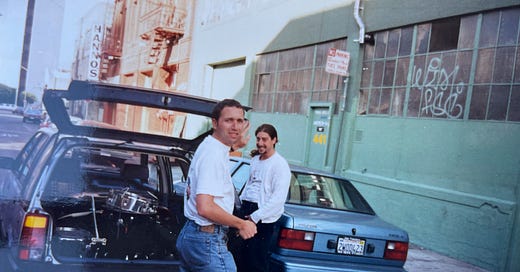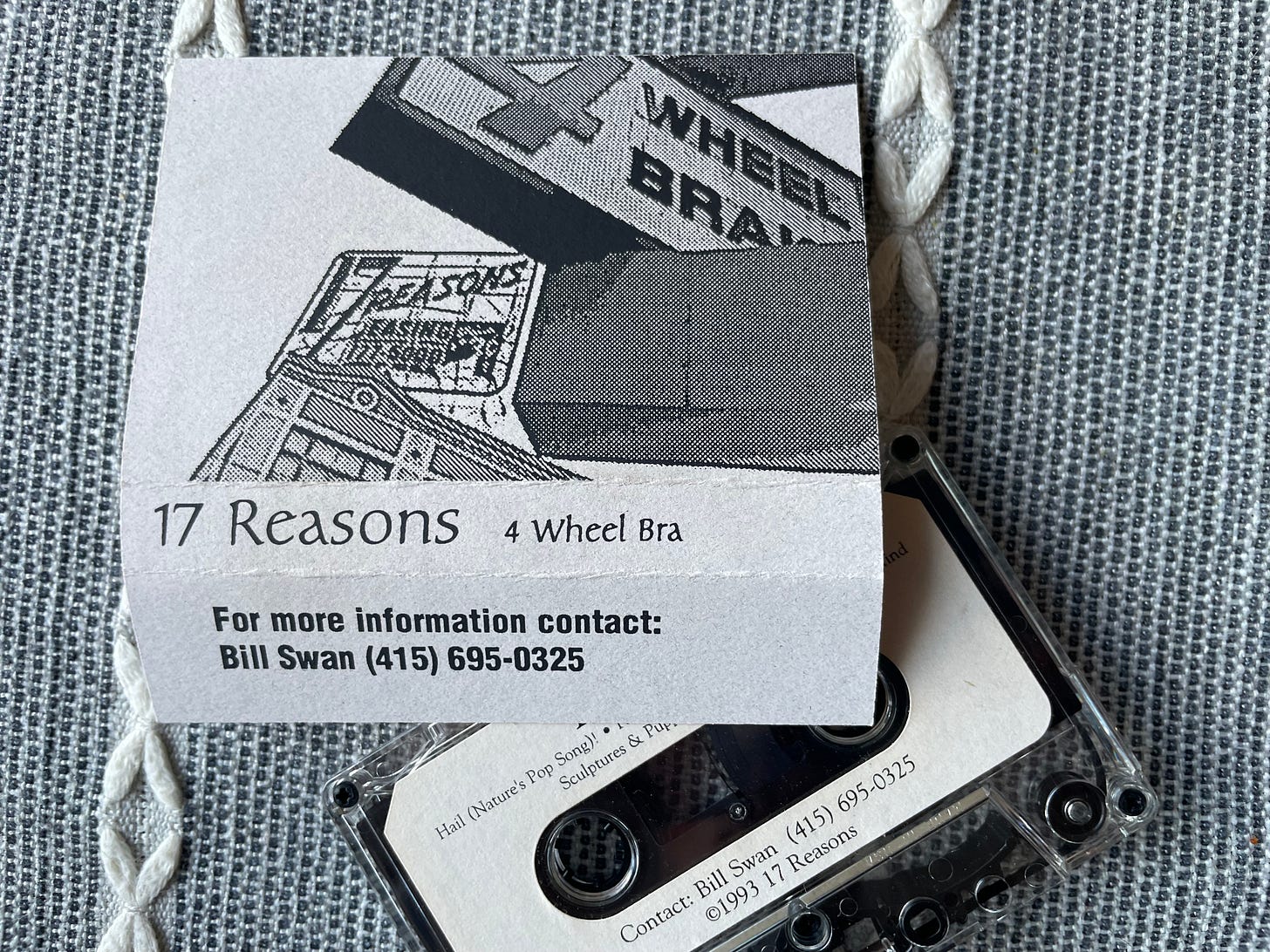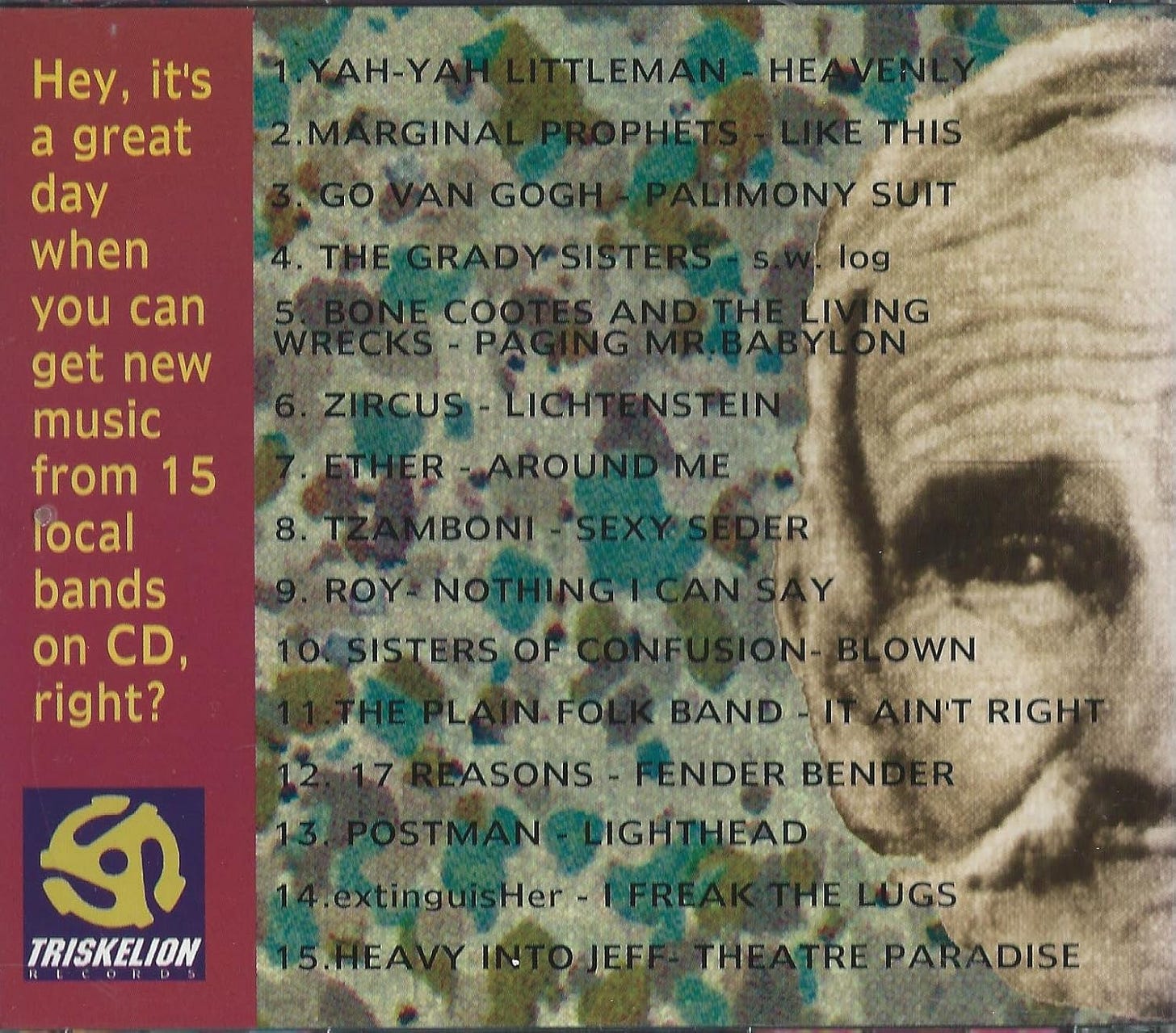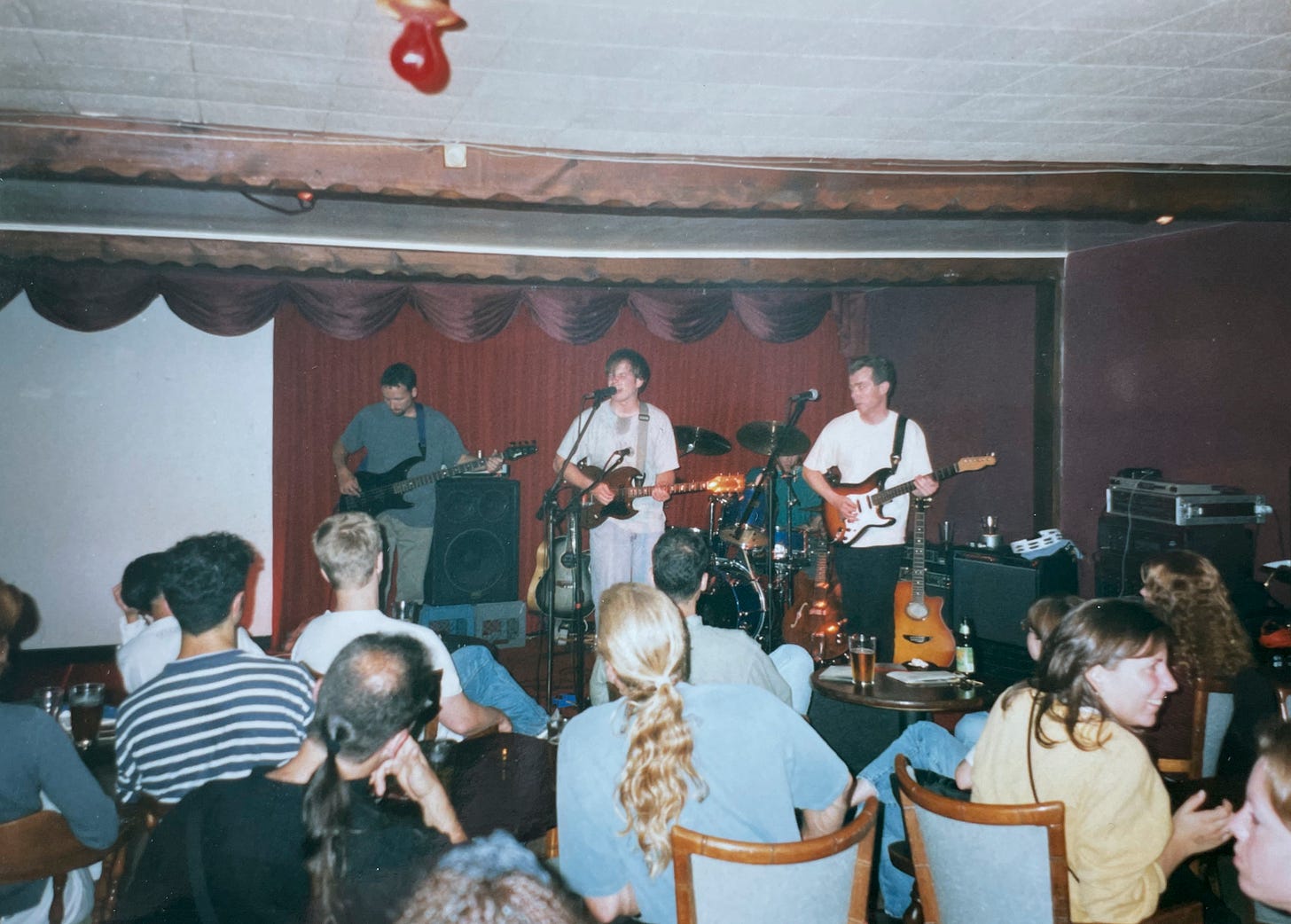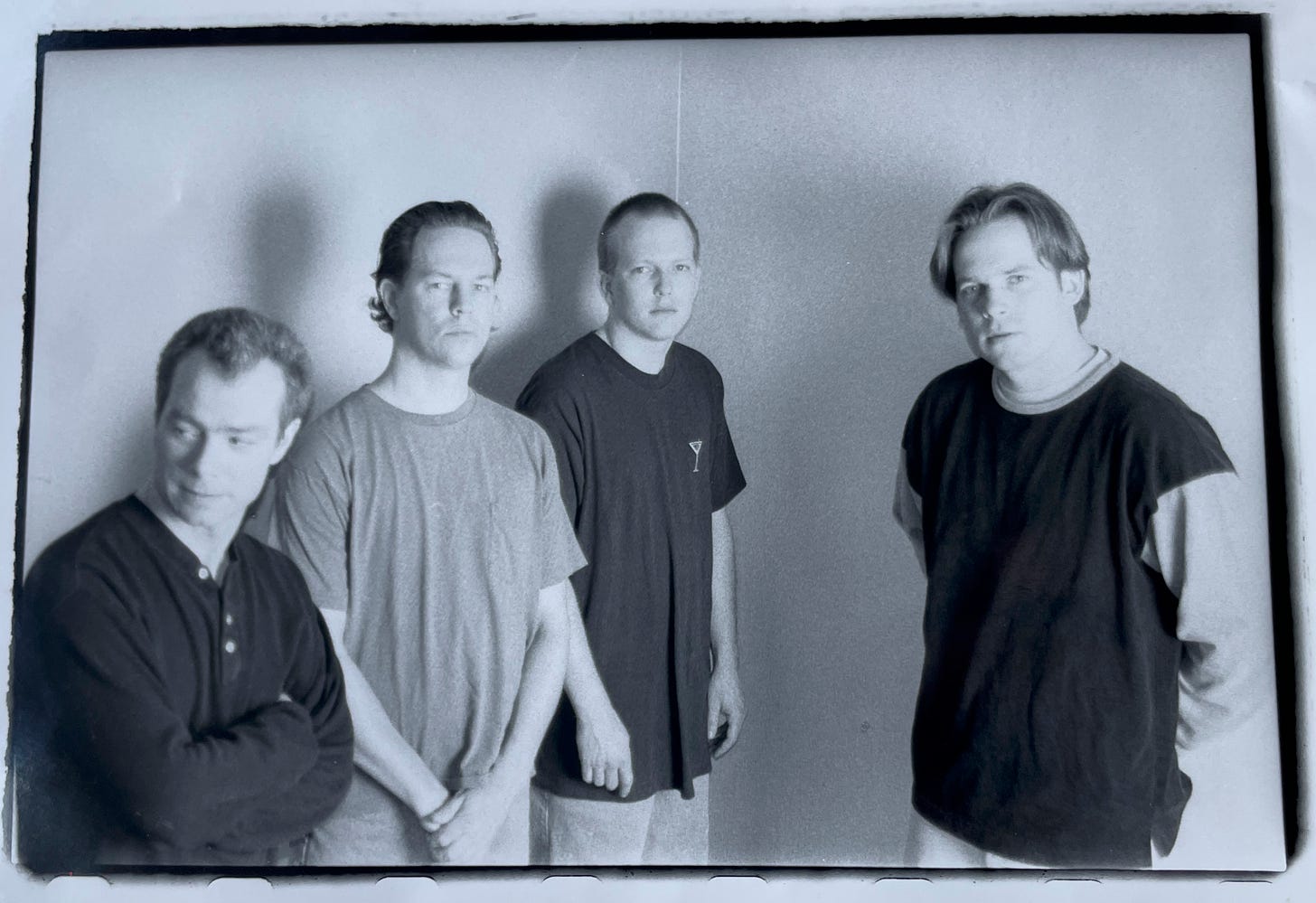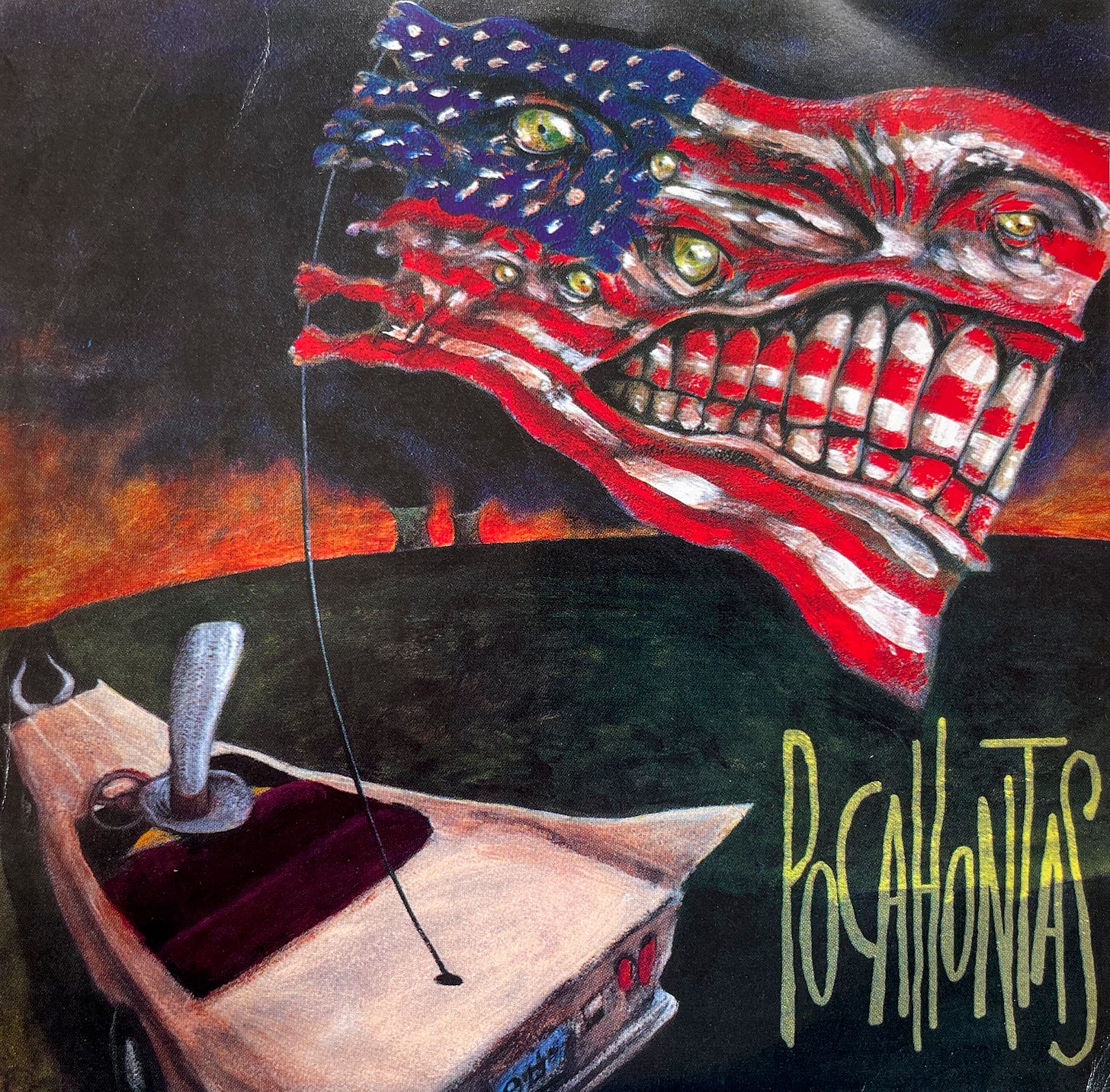SF band before Beulah. Thanks, dear readers, for sticking with me. There were two forks in the road I could have taken after the intro which ended in “fortunate accident.” The path that I chose leading here, or a path that could have jumped ahead to next week. When I asked my daughter, Brenna, what path I should take, she said “Dad, it’s your story. People don’t have to read it if they don’t want to.”
17 Reasons
It became apparent not long into my first year in San Francisco that Kristin wasn’t looking to settle into a relationship. Being honest with myself, neither was I. It was San Francisco, we were young - timing is everything. She would end up moving back home to D.C. before the year was up, and then Mexico after that. But through her I met Seth Walter, a bass player who was trying to put a new band together with his half brother, Lee Farber, on drums.
It took a while for Seth to get in touch with me. Kristin had given him a copy of the Strange Bedfellows tape I’d given her while I was still living in Wisconsin, but as I found out later, Seth was taking care of his girlfriend Noel, who had been diagnosed with breast cancer. By July of ’93 Noel’s cancer had been in remission for a number of months, and Seth was ready to get out and play music again. I happened to be over at Kristin’s place in the Mission when Seth called her, asking for my number. She did one better and handed the phone to me.
I went over to their house at 20th and Guerrero a couple of days later. Noel answered the door and the first thing she did was hand me a beer. It was a Sierra Nevada Pale Ale. This felt like an official “welcome to San Francisco” moment, and for the next year and a half or so, Jason and I were invited over to their house and their friends’ houses for parties and even family dinners during the holidays. We were sort of a curious pair I think, providing comic relief at these gatherings with our strange, insular vernacular of weirdness delivered in thick Wisconsin accents. We were treated like family. It was nice because I felt homesick at times that first year.
A week later, Seth, Lee, and I were practicing in Lee’s bedroom just up the street from Seth and Noel’s at the corner of 21st and Guerrero. Lee said that some of the members of Pansy Division lived upstairs (Dan “Panic” Sullivan would tour with them opening for Green Day a year later, and I’d see Danny on MTV).
Seth and Lee had only listened and practiced to the Strange Bedfellows tape (“Down, Down, Down”) for about a week and by the time I showed up, they knew the songs left and right. That was a starting point. Soon we were working on some new songs of mine and after a month went by we had about forty songs in our set. I was still playing clean and fast rhythmically, with the drums and bass filling in the spaces. We were manic, a tighter, faster, slightly jazzier and funkier version of Strange Bedfellows.
L to R: Seth Walter, Lee Farber. Bottom - hood of the FURY, July, 1993
We reached an impasse on what to name the band. Strange Bedfellows was out. I considered that a dead name because Greg Norman wasn’t in the band, though it might have fit my new trio almost as well as the previous one. After many terrible suggestions, Seth said, “There’s this big metal sign in the Mission that says ’17 Reasons.’ Let’s call it that.” I was underwhelmed, but…fine. I thought the name was boring though. He kept saying, “You have to see that sign.”
According to my ledger, our first club gig was February 12th, 1994 at Spikes on 7th and Minna. Spikes was the other club that Marie Swan had recommended back at that open mic in Austin. Not long after, we played at The Blue Lamp, a club in the Upper Tenderloin or “Lower Nob Hill,” as the area is euphemistically called.
Most of the clubs we played were pretty small. But even then, within a year things began to stall out for us. Seth had a friend named Cinnamon who called clubs to try and get us gigs, but her efforts didn’t help much. It might have been because of the company name she used: “Severed Hand Promotions.”
We put together a six-song demo and called it “4 Wheel Bra.” When I finally got around to “seeing that sign,” I took a picture of it, which cut off part of the “4 Wheel Brake” auto shop across the street. It became the cover art. Calling it “4 Wheel Bra” was also Seth’s idea, a pretty good example of his dry sense of humor:
Originally, that sign said “17 Reasons Why,” but it was explained that the “why” fell off during the Loma Prieta Earthquake in 19891. One of the songs off of 4 Wheel Bra was included in a local compilation CD called Quixotic, a good cross section of local SF talent in 1993:
It didn’t take long before Seth and Lee, but especially Lee, suggested we add a lead guitar player. Lee said he knew of a guy who was supposedly “the shit” on guitar, Rick McKay. So, we brought Rick over to Lee’s bedroom and tried him out. He was obviously a great player, so he was in before I had a chance to let it all sink in.
Rick was from Flint, Michigan and cut his teeth playing and touring with, mostly, cover bands throughout the Midwest before moving out to SF in 1982. I remember bringing in a packet of lyrics for Rick during that practice and plopping them on the floor in front of him. Thunk! I think there must have been about fifty song lyrics in the packet. Rick looked mildly puzzled, which was understandable. But it was a good thing he joined when he did, because the downstairs neighbors were starting to get pissed off at Lee for having band practice in his bedroom, despite the heavy dampers he had on the drums and cymbals.
In April of ‘94, we moved into Rick’s rehearsal space in an old warehouse on 17th and Potrero called “The Art Explosion,” also known as “Uncle Walt’s.” Beulah’s first two records would end up being recorded in that very same room. Lee said he helped put up the drywalls to partition the rooms in the warehouse. I doubt they were up to code, they wouldn’t have passed any earthquake inspection. We practiced fairly regularly and played a small handful of gigs with Rick but then he quit.
We had played a show that June at The Casanova, a small club on Valencia St. between 16th and 17th. One of the songs was a joke song I had introduced called “Ain’t That The Shits.” It was a breakup song centered around how I shouldn’t have trusted that fart in a new pair of fancy underwear I’d bought. Jason Ries gets co-credit for this classic gem:
Went down to Nordstrom’s underwear central thinking all about sex
Bought a pair of Marky Mark Calvin Klein briefs for $17.36
Could’ve paid my bills with the wad I blew just for “honey, get a load of this”
and saved a bit o’ money ‘stead of feelin’ somethin’ funny singin’ “ain’t that the shits”
Ain’t that the shits, ain’t that the shits
that sittin’ and thinkin’ always ends coming out like this?
Ain’t that the shits, ain’t that the shits
that it ain’t what you have, it’s what you done had --
and ain’t that the shits
This song was just about the only crowd pleaser, but Rick was not amused. He said he didn’t want to play gigs that felt like a frat party. Another reason, I found out later, was that he was sick of Lee, who was late paying studio rent for the third month in a row. Rick snapped “The bank of Rick is CLOSED.”
17 Reasons became a trio again. Rick let us keep our slot in his practice space though, and he began rehearsing there with some of his mates as the backing band for Allison Faith Levy, the pianist/songwriter whom I’d opened for at the Albion for my very first solo gig in town. During this period, 17 Reasons had the best paying gig it would ever get, and the amount was a clear indicator of the financial projections, thus far, of my musical career. It was for a corporate Halloween party in the parking lot of SF General Hospital. Lee got us the gig and it paid $400, the same amount as the highest paid gig I’d played to date, the very first one by Rapture at the Jefferson Junior High School Dance way back in 1987. According to the bureau of labor statistics, though, $400 in 1994 was worth only about $308 in 1987. I only remember one other thing about that gig besides the money: we did a cover of “Hunka Hunka Burnin’ Love.” I did not dress up like Elvis.
The “Hunka Hunka” gig would be our last with Lee Farber. Lee was incredibly gifted, but Seth and I were getting to a point where we wanted to slow things down a little, give songs more space to breathe, have a simple backbeat once in a while, and Lee wasn’t that type of player. We were also thinking, still, of expanding our lineup. We’d tried out some other guitar players in the interim, but there wasn’t really a place for them with all the manic polyrhythms that were happening.
The timing of Lee’s ouster was less than optimal, it was right after the “Hunka” gig, and his first reaction was to ask for the rest of $400 that had been split between the three of us for “back payment of Union wages.” Before we could press our case that 17 Reasons was a band headquartered in a “right to work” state, clearer heads prevailed: No hard feelings, musical differences, farewell and good luck.
Seth knew a drummer he used to play out with on occasion, John Miller, and suggested he’d be right for where we were headed. Trouble was, John had a lot of other gigs with different bands, so it was hard to find time to practice. When we did, I started using more acoustic guitar, especially this nylon string guitar that I’d recently rediscovered. I had “inherited” it from Dave Konkol, of all people, who’d borrowed it from the lead singer of that cover band he got kicked out of for drunkenly falling off his drum stool in the middle of a song. If you played that guitar a certain way with a pick, you could get this percussive clicking sound off the edge of the fretboard, and I began writing songs incorporating that sound, among other percussive effects. That guitar endured a fair degree of physical abuse.
Right around this time I was beginning to use a Tascam 238, a rack mount 8-track cassette machine – a step up from the tabletop Portastudio 4-track – for some of my solo material, mostly the nylon acoustic with some trumpet lines and bits of percussion peppered in. The Tascam was in the practice space and belonged to Neil Robinson, a friend and band mate of Rick McKay’s in Allison Faith Levy’s band. Rick agreed to record 17 Reasons with the same machine and work on what he may have considered a demo, but I thought could be a “record.” I’d only ever released tapes to this point anyway, so what was the difference? The songs we were working on had drum tracks from Lee before we kicked him out, but we continued to work on it afterwards. We’d end up calling it “In the Ditch.”
This project really did end up in the ditch. We had tapes pressed and printed with a font dangerously close to Comic Sans, but we never got around to making any artwork for the sleeve.
It seemed clear at this point that Rick wanted to re-join the band now that Lee was out of the picture. He complimented me on my songwriting, saying I was one of his favorite songwriters in the city. He also spent a lot of time with me working on overdubs for the 17 Reasons songs and the mixes. This was when he taught me about signal flow through the mixing board to the tape machine, what buses were and EQ settings and so forth, in a way that I could understand it, and that allowed me to come in and record whatever I wanted when no one was in there.
Seth wasn’t around that much during this time and there was a really good reason for that. Noel’s cancer had returned, and the prognosis was not good. They gave her three to six months to live.
Change Brewing
17 Reasons as a working band was put on hold as Noel’s health grew worse rather quickly. I regret not being present, but I was afraid to be a bother and go over to Seth’s and Noel’s to pay a visit. I went from going over there quite a lot for barbecues and the like, to not going over there at all. Seth, in his usual, understated way, said “don’t be a stranger.” I wish I could have had that time back.
Instead, I withdrew into my own little musical cocoon, barely socializing with anybody. Now that I knew how to record with better equipment, I decided to take it a step further and enroll into the SF State Music and Recording Industry Certificate program and take some recording classes during the evenings. My childhood interest in messing with tape recorders was rekindled; I then realized I had the potential to do everything on my own if I wanted. I also began practicing the trumpet again after a long absence. The things I learned in separate streams as a kid started to coalesce.
I’d learned a few rudimentary things about mixing boards in working with Jeff Jagielo on the Plymouths and Strange Bedfellows projects back in Wisconsin, but I didn’t really understand the concept of signal flow through a board from point to point until Rick first showed me. I refined that knowledge in the classes, which were all taught by Professor Josh Hecht at SF State. The best class was the first, where basics about electronics and waveforms were discussed theoretically. And later, when I began recording Beulah, I had a better idea of the reasons why that room sounded crappy and why I couldn’t do much of anything about it without resorting to desperate, and ultimately creative, measures.
I spent every moment I could in the practice space, going through mixes of 17 Reasons songs with Rick or recording acoustic based material on my own. I put together a collection of solo songs that I would dub “Mighty Meek,” under a moniker provided by Jason, “Will O’Schwantz,” using my new-found recording skills. I started mailing copies of “Mighty Meek” to a network of kids out in the Sacramento valley that I’d been corresponding with as a result of a few shows at some art spaces and cafés I played there on occasion.
This tape was a DIY special. Handwritten “artwork” by yours truly. It looks like I probably “borrowed” that flag from the cover art for a 7” of Miles’ band, Pocahontas2.
This all started out of the blue one night when a kid from Sacramento I’d never met, Matt Stauss, called to tell me how much he dug 17 Reasons. It seems he was an acquaintance of Lee Farber who’d seen one of Lee’s old bands play a gig in Sacramento a few years before my time. Lee sent him the 17 Reasons demo which had my phone number on it. Matt would call me at weird times like three in the morning on a work night and we’d chat about music for hours. Every now and again I’d meet someone I could talk to like he was my little brother, even though I never had one. Matt was one of those people.
He was eighteen at the time, looking to get into music as a manager or booker, and he put together gigs wherever he could. Some of these shows were interesting. A singer/cellist named Madigan played at more than one of these gigs. She was a fiery performer and would go on to form Bonfire Madigan.
These gigs were important confidence builders for my new style of playing on the nylon guitar and DIY approach to recording. I’d seen another singer-songwriter at a co-op show in Berkeley thanks to a tip from Matt, the great Elliott Smith. I had first learned of him from Seth, who said Elliott’s voice and songs reminded him a lot of the solo stuff he’d been hearing from tapes I’d given him. I bought his self titled CD. There was no comparison, really. Soon enough his approach to music, especially singing, would have an influence.
At the co-op, no one was really managing the sound system, and I remember just itching to walk over there and tweak the EQ. You couldn’t really hear Elliot’s vocals, and the mic was feeding back a lot. A band called Track Star also played that night - I think it was after Elliot’s set. Their show would also have an impact - I noticed that the lead singer and guitarist had his guitar tuned to C# regular tuning. I thought that sounded cool, and I would start doing that myself. To this day I keep a guitar at home tuned to C#. I just like the way it sounds - it has a modicum of sadness, for lack of a better word. I wouldn’t see Elliott Smith live again until 1997, at the legendary Bottom of the Hill in the Potrero district -- to this day one of the best solo acoustic performances (and nuanced, live sound quality) I’ve ever seen in a club setting.
Seth, John Miller, and I rehearsed for our first gig in the second incarnation of 17 Reasons, planned for the Edinburgh Castle (Geary and Larkin) on February 25, 1995. After a time, Seth had concluded that the best medicine for Noel, or the best way he could do his part to put good energy out there to help her get well, was to play rock and roll. But then, the night before the gig, Noel lost her battle. She was 30 years old. Seth told me that the show should go on, so I called Rick to see if he would be willing to play an acoustic set with John and me in place of Seth, and Rick jumped right in. He brought his mandolin, too. It was a sit-down affair. For some reason, I brought bagels, put ‘em to the side of the stage, and called it the “nosh pit.”
Not long after, Rick told me that he wanted to rejoin 17 Reasons. I told him I wasn’t really looking for a lot of elaborate guitar solos, and that to start with, I’d like for him to play the mandolin, acoustic guitar and occasional electric. I was trying to bring in what I learned with the Plymouths and build a foundation atop of the acoustic based, “mighty meek” material I was recording. Seth came back and began rehearsing with us once he felt ready and we became a four-piece again.
This second incarnation was probably my favorite period in 17 Reasons. I felt it was our most creative because we were mixing in a lot of dark and weirdly rhythmic acoustic material as well as some rock material. It was a fusion of my two identities: band guy and solo acoustic guy, and it felt fresh. During the spring and summer of ‘95, we scheduled a fair number of gigs at the Edinburgh Castle, a small room not unlike The Chamber back in Madison that would look packed with fifty people. The feel was similar at times to some of the shows out in Sacramento.
We had a deceptively elaborate setup; I think I had four different guitars on those small stages. I wanted to use different, slack key type tunings like D-A-D-G-A-D (learned that one from Jeff Jagielo back in WI), my new found C# tuning, and so on, and Rick suggested it would be better to have more guitars with these preset tunings than to take two minutes between songs to tune one guitar. I wanted to use nylon acoustic for some songs, and steel string for others. Rick brought his technical expertise in sound to better capture the subtler elements of my acoustic playing for both types of guitar sounds and to even out the disparities in volume and tone where possible. I’d use a compressor on electric from here on out. I learned a lot about tightening up gigs by observing Rick at work. He was an excellent teacher.
Second incarnation of 17 Reasons. L to R: Seth Walter, me, John Miller, Rick McKay, Edinburgh Castle, 1995
Though this period felt creative, it was short lived, with scant recorded evidence. Sometime during that summer, Seth decided to move back home to Brooklyn. This was probably the best way to deal with his grief, to go to New York and regroup. Noel had been studying Environmental Law at Hastings, and that was the main reason they moved to the Bay Area in the first place, back in 1989. Seth left in September of 1995, and asked me if I wanted to follow suit and move to New York with him.
I came close to doing just that. When I first knocked at their door in ‘93 and Noel had handed me a beer, I was on the verge of moving back to the Midwest. But Seth and Noel made Jason and me feel we were a part of their chosen family. After Noel died, and Seth left, many of his friends and their siblings from that circle were soon to follow, including Beth, Noel’s sister who was one of the friends of Kristin’s who had passed through Green Lake on the way to SF in ’91. Her husband Eric would soon get a job as a professor in Astronomy back east.
I really didn’t have a reason to stay either. My job was stupid, I had no girlfriend, and now I didn’t really have a full band. But I decided to stay in the Bay Area for a little bit longer. I’m glad I did. Six months later I’d meet my wife, Kiera. And I would get a call from a work-related acquaintance that would change my musical life as well.
After Seth left, Rick began speaking up about his ideas for this band, like having a more modern sound. He said he had people lined up to help us get to the next level if we did. What he really meant was to make it loud, to turn it up. I had to think about it. Rick had a big influence on my development as a player, music director and recording engineer, but at this point in time, it became clear to me that the two of us might have a difference in opinion about what we wanted out of being in a band.
I had been emboldened by my experience playing acoustic sets out in Sacramento and one at a hip little coffee shop in SF called Java Supreme that went over pretty well, hosted by Dan of the band Ed’s Redeeming Qualities. Adam from the Mommyheads was in attendance. I’d been reading an Elliott Smith interview where he said he started doing solo material because he was tired of the loud rock band format of his band, Heatmiser, and couldn’t stand to hear the way his voice sounded when he tried to growl over all of the distortion. I was feeling pressured to move in the opposite direction.
A couple of weeks went by, and I was on the verge of saying “forget it,” that I was going to move to New York and keep a band going with Seth, but I just didn’t feel like making another big move across the country. And I thought to myself that there was no harm in trying things someone else’s way. What if Rick was right? I hadn’t gotten much of anywhere so far doing things my way. Little by little I was coming to the conclusion that I didn’t want to be the one calling all the shots for the band that I was in.
So, 17 Reasons shifted gears. I was still the lead singer and songwriter, but Rick became our musical director. He bought a Marshall half stack, and he lent me his old amp and money for a new guitar. He also lent me his 1968 Gibson SG. And he brought in another old band mate of his, Ryan Gabel, on bass. Ryan played in a group of Rick’s called Meatball Heroes, along with Neil Robinson, owner of the Tascam 238 I’d been recording with. He also played with the two of them in Allison Faith Levy’s band. Ryan wasn’t a virtuoso, but he was solid, in the pocket. We put out an ad for a drummer, because Rick felt that John’s playing was a little light to the touch for where we were going to go. Plus, John was in too many other bands, and it was hard to pin him down for practice. And we were about to practice very regularly.
We eventually met with Randy Gzebb at Eichelberger’s, a now defunct bar down the street from the practice space. I’m pretty sure our first meeting was the night when the place was unusually packed. I wondered who all of those strange-looking ladies were, sipping cocktails and talking in lower voices. It was transgender night.
Randy was a solid beat drummer, used to play in Love Club, a gothic rock band signed and dropped from MCA records back in ’90 or ’91. I was impressed to see that they had opened at the Fillmore and were on one of the posters on the wall display upstairs. They opened for Midge Ure. Randy began name-checking all kinds of industry people he knew, like Howie Klein, and said that he only joined bands he thought were worthy of being signed. He said this seemed like one of them. I was flattered by that.
We began rehearsing three nights a week in early October of ‘95, from nine to midnight. I’d have to be at work by six in the morning, so lack of sleep soon became an issue. Meanwhile, I got a call out of the blue at work from Miles Kurosky. He wanted to know if I would help him record some of his songs.
Third incarnation. L to R: Rick McKay, Randy Gzebb, Ryan Gabel, me, intended for 7x10” glossy promo, ‘95 or ‘96 (I think).
[Next chapter here.]
https://www.foundsf.org/index.php?title=17_Reasons_Remembered - This article provides some of the history, and locates the “why” part of the sign, though it says it was “taken down before 2002.” There is also a picture of it in 1989 with the “why” still on it, so I am going with what I had heard at the time, which is that it fell off during the Loma Prieta quake.
